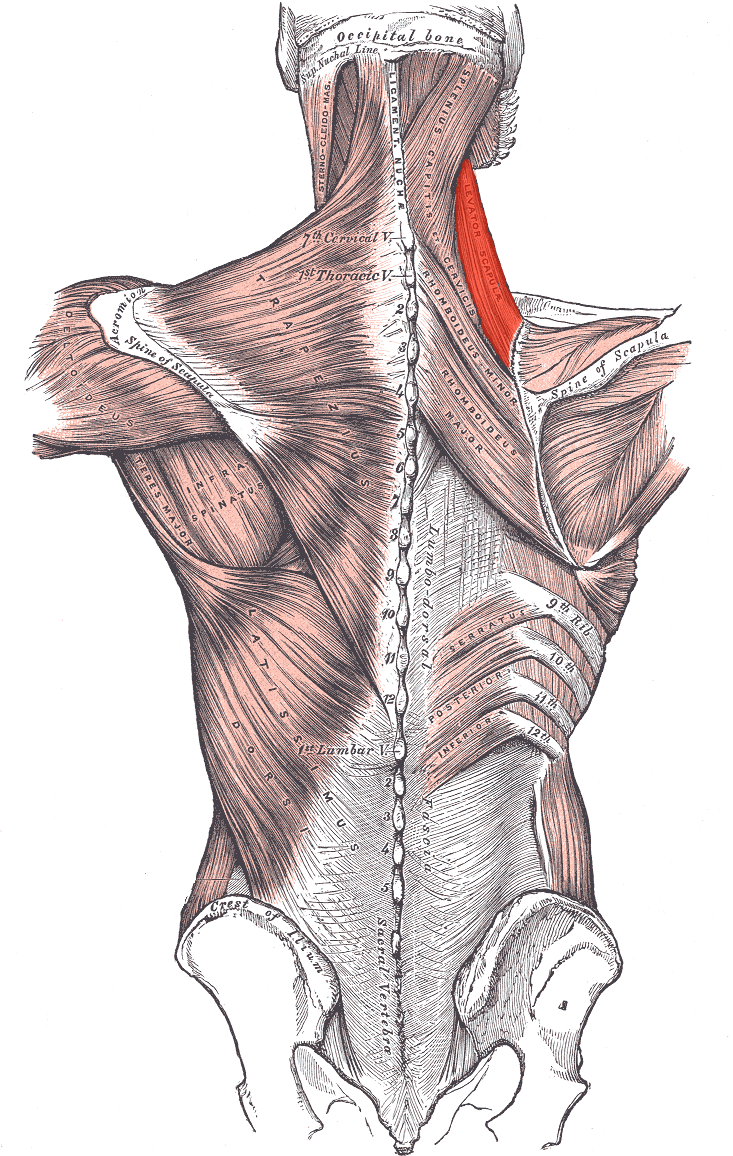I think muscles are often overlooked during a physical exam by medical doctors, chiropractors and physical therapists. They are usually neglected in treatment as well. Some chiropractors will only address the joint and manipulate, some medical doctors may prescribe a muscle relaxer, some physical therapists may think e-stim or ultrasound are the only means to dealing with the pain.
The reason I think this is important to discuss and spread the word about is because I have met many people that have shelled out a lot of money to fix their problems. A lot of times I have witnessed their problems were never fixed, because they were never assessed for muscle trigger points or muscle imbalances. This usually ends in what I like to call “empty wallet syndrome.”
The Muscle: Levator Scapulae
I think the most fitting muscle to start with is the levator scapulae. Levator’s Latin root is “elevator.” Scapulae is Latin for “shoulder blade.” So, you can guess what this muscles helps with right? This muscle help elevate the shoulder blade. Elevation of the shoulder is the same movement as shrugging, or the “I don’t know” movement.
This muscle is attached to medial superior border of the scapula (shoulder blade) and the transverse processes of the middle and upper cervical vertebrae.
The Symptoms:
Trigger points in this muscle can lead to the following symptoms
- Neck muscle pain and soreness
- Neck stiffness
- Lower neck pain
- Pain with rotating the head
- Pain with lateral bending the head (bringing your ear to your shoulder)
- Pain between the shoulders
- Pain on the shoulder blade
Trigger points can radiate pain into the back side of the head, middle back, and sometimes even to the TMJ (Temporomandibular Joint).
Everyday painful activities that may be caused by the levator scapulae
- Pain with turning head to switch lanes in your car
- Pain with shrugging or arm intensive workouts
- Carrying a purse
- Tension in the neck while sitting at your desk
The Cause:
- Stress by overexertion during exercise or repetitive motion
- Emotional stress
- Sleeping with little support from a pillow
- Poor posture
- Car accidents – Whiplash
- Past case of whiplash
- Carrying objects that create elevation of the shoulder, i.e. purse, backpack, etc.
- Hiking shoulders due to work desk
- Muscle imbalances causing increased tone
Treatment Options:
There are many treatment options for levator scapulae muscle soreness. I think one of the best forms of treatment is finding out what is causing this pain. If you have poor posture at work, take a break every 30 minutes to reset. If you have poor shoulder biomechanics while exercising, focus on keeping the shoulder in a good position. If you’re a stressed out person, try to clear your mind when you find yourself stressed.
Trigger point therapy or a more advanced form of muscle release can be used to help quickly facilitate the muscle to relax. I have training in Functional Range Release and have had great results utilizing this technique.
Self treatment and prevention should be the goal for everyone. You can purchase a trigger point cane (found here http://www.amazon.com/Thera-Cane-JMAS5000-Massager/dp/B000PRMCJU), buy a lacrosse ball or use a tennis ball to help release the levator scapulae yourself.
Joshua L. Thorp, D.C.
Sources:
Davies, Clair, and Davies, Amber. The Trigger Point Workbook: Your Self-Treatment Guide For Pain Relief. Oakland: New Harbinger Publications, Inc., 2004. Print
Simons, David G., Lois S. Simons, and Janet G. Travell. Travell & Simons’ Myofascial Pain and Dysfunction: The Trigger Point Manual. Baltimore, MD: Williams & Wilkins, 1999. Print.

